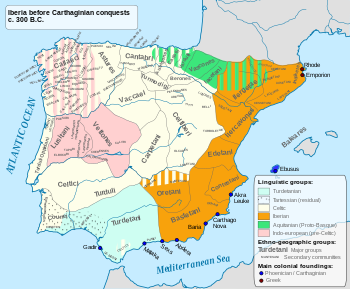
The Iberians were an ancient people settled in the eastern and southern coasts of the Iberian peninsula, at least from the 6th century BC. They are described in Greek and Roman sources. Roman sources also use the term Hispani to refer to the Iberians.
The Lusitanians were an Indo-European speaking people living in the west of the Iberian Peninsula prior to its conquest by the Roman Republic and the subsequent incorporation of the territory into the Roman province of Lusitania.

Spaniards, or Spanish people, are a Romance ethnic group native to Spain. Within Spain, there are a number of national and regional ethnic identities that reflect the country's complex history, including a number of different languages, both indigenous and local linguistic descendants of the Roman-imposed Latin language, of which Spanish is the largest and the only one that is official throughout the whole country.

The verracos, in the Iberian Peninsula, are the Vettones's granite megalithic monuments, sculptures of animals as found in the west of the Iberian meseta – the high central plain of the Iberian peninsula – in the Spanish provinces of Ávila, Salamanca, Segovia, Zamora, Cáceres, Ourense and the Portuguese provinces of Beira Baixa, Beiras e Serra da Estrela, Douro and Terras de Trás-os-Montes. Over 400 verracos have been identified.

The Vettones were a pre-Roman people of the Iberian Peninsula of possibly Celtic ethnicity.

The Cynetes or Conii were one of the pre-Roman peoples of the Iberian Peninsula, living in today's Algarve and Lower Alentejo regions of southern Portugal, and the southern part of Badajoz and the northwestern portions of Córdoba and Ciudad Real provinces in Spain before the 6th century BCE. According to Justin's epitome, the mythical Gargoris and Habis were their founding kings.

The Celtici were a Celtic tribe or group of tribes of the Iberian peninsula, inhabiting three definite areas: in what today are the regions of Alentejo and the Algarve in Portugal; in the Province of Badajoz and north of Province of Huelva in Spain, in the ancient Baeturia; and along the coastal areas of Galicia. Classical authors give various accounts of the Celtici's relationships with the Gallaeci, Celtiberians and Turdetani.
The Interamici or Interamnici were a pre-Roman people or tribe, one of the Gallaeci tribes, living between some areas of modern southern Galicia (Spain), and some areas of northern Trás-os-Montes, modern northeast Portugal. Their name means "Between Waters" because they lived between the southern banks of the Minius (Minho) and Sil rivers and the northern headwaters of the Laethes or Limia (Lima) and Tamica (Tâmega) rivers.
The Narbasi were an ancient Celtic tribe of Gallaecia, living in the province of Minho and nearby areas of modern Galicia (Spain).
The Turodi were an ancient Celtic tribe of Gallaecia, living in the north of modern Portugal, in the province of Trás-os-Montes and border areas in Galicia (Spain).

The Vaccaei or Vaccei were a pre-Roman Celtic people of Spain, who inhabited the sedimentary plains of the central Duero valley, in the Meseta Central of northern Hispania. Their capital was Intercatia in Paredes de Nava.

The Gallaeci were a Celtic tribal complex who inhabited Gallaecia, the north-western corner of Iberia, a region roughly corresponding to what is now the Norte Region in northern Portugal, and the Spanish regions of Galicia, western Asturias and western León before and during the Roman period. They spoke a Q-Celtic language related to Northeastern Hispano-Celtic, called Gallaecian or Northwestern Hispano-Celtic. The region was annexed by the Romans in the time of Caesar Augustus during the Cantabrian Wars, a war which initiated the assimilation of the Gallaeci into Latin culture.

The Bastetani or Bastuli were an ancient Iberian (pre-Roman) people of the Iberian peninsula. They are believed to have spoken the Iberian language. The relationship between the Iberian Bastetani and the Tartessian Mastieni is not entirely clear.

The Carpetani were one of the Celtic pre-Roman peoples of the Iberian Peninsula, akin to the Celtiberians, dwelling in the central part of the meseta - the high central upland plain of the Iberian Peninsula.

Hispania was the Roman name for the Iberian Peninsula and its provinces. Under the Roman Republic, Hispania was divided into two provinces: Hispania Citerior and Hispania Ulterior. During the Principate, Hispania Ulterior was divided into two new provinces, Baetica and Lusitania, while Hispania Citerior was renamed Hispania Tarraconensis. Subsequently, the western part of Tarraconensis was split off, first as Hispania Nova, later renamed "Callaecia". From Diocletian's Tetrarchy onwards, the south of the remainder of Tarraconensis was again split off as Carthaginensis, and all of the mainland Hispanic provinces, along with the Balearic Islands and the North African province of Mauretania Tingitana, were later grouped into a civil diocese headed by a vicarius. The name Hispania was also used in the period of Visigothic rule.

The Pellendones were an ancient pre-Roman Celtic people living on the Iberian Peninsula. From the early 4th century BC they inhabited the region near the source of the river Duero in what today is north-central Spain. The area comprises the north of Soria, the southeast of Burgos and the southwest of La Rioja provinces.
The Castellani or 'Castelani',, were an ancient Iberian or Pre-Roman people of the Iberian peninsula. They inhabited the bottom of the eastern Pyrenees in the northern Tarraconense.








